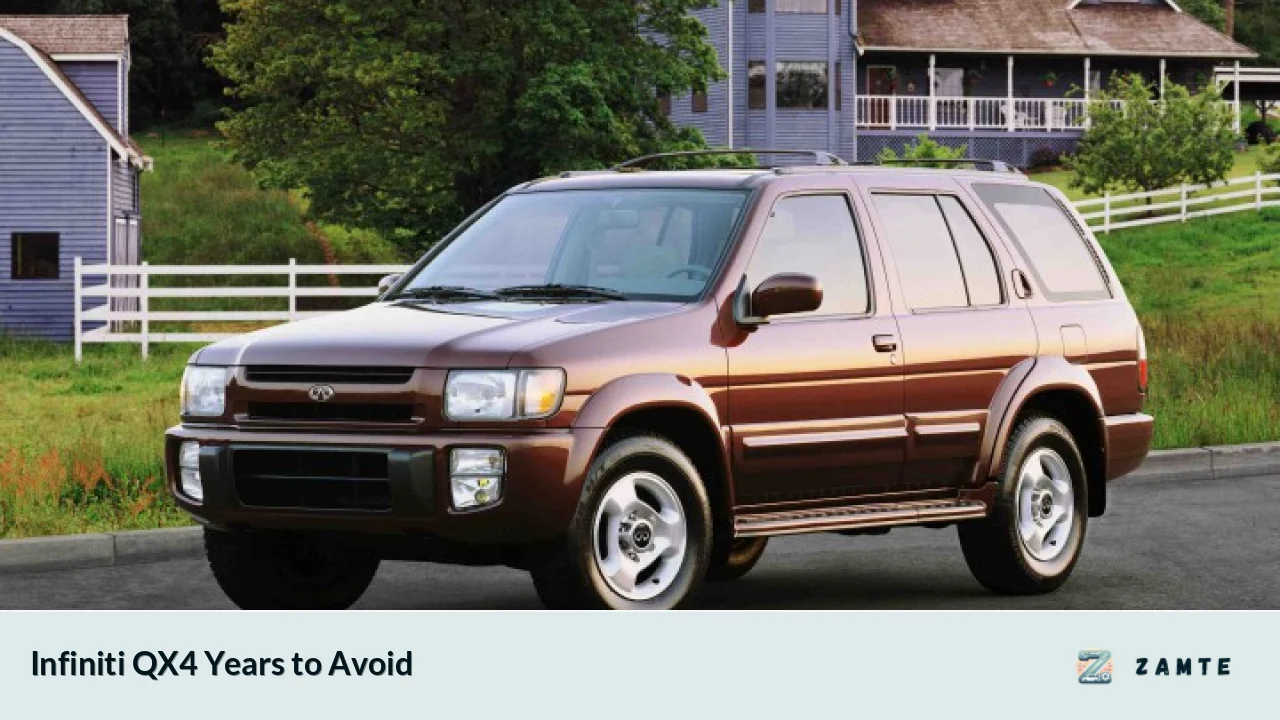The Infiniti QX4, a luxury SUV produced from 1997 to 2003, was Infiniti's first entry into the SUV market. While it offered a comfortable ride and upscale features, certain model years have been known to experience more issues than others. Here's a comprehensive look at the QX4 years to avoid and the common problems associated with this vehicle.
| Model Year | Reliability Rating | Common Issues |
|---|---|---|
| 1997-1998 | Average | Transmission problems, suspension issues |
| 1999-2000 | Below Average | Engine misfires, MAF sensor failures |
| 2001 | Poor | Widespread coil pack failures, ECT sensor issues |
| 2002-2003 | Above Average | Minor electrical problems, some suspension wear |
The Troublesome 2001 Model Year
The 2001 Infiniti QX4 stands out as the most problematic year in the vehicle's production run. This model year experienced a host of issues that led to frequent repairs and frustrated owners[1]. The most significant problem was the widespread failure of ignition coil packs, which caused engine misfires and poor performance[2].
Many 2001 QX4 owners reported that their vehicles would suddenly lose power or stall while driving, creating potentially dangerous situations. The root cause was traced back to faulty ignition coil packs, which were prone to premature failure. This issue was so prevalent that Infiniti issued a recall for the affected vehicles.
In addition to the coil pack problems, the 2001 model also suffered from issues with the Engine Coolant Temperature (ECT) sensor. Faulty ECT sensors could cause erratic idle speeds, poor fuel economy, and in some cases, trigger the check engine light[3].
Engine and Transmission Woes in Earlier Models
While the 2001 model year was particularly troublesome, earlier QX4 models weren't without their share of problems. The 1997-2000 models experienced various engine and transmission issues that potential buyers should be aware of.
The 1999 and 2000 model years were plagued by problems with the Mass Airflow (MAF) sensor. A failing MAF sensor could cause the engine to run roughly, stall, or limit the vehicle's acceleration to around 3600 RPM[1]. This issue was often accompanied by a check engine light and required replacement of the sensor to resolve.
Transmission problems were also reported in the earlier models, particularly in the 1997-1998 QX4s. Some owners experienced harsh shifting, slipping, or complete transmission failure. While not as widespread as the engine issues in later models, these transmission problems could be costly to repair.
Suspension and Steering Concerns
Across multiple model years, the QX4 has been known to develop suspension and steering issues as the vehicle ages. The front strut housings, in particular, have been a point of concern. In areas where road salt is heavily used, corrosion can occur in the strut housing, potentially leading to steering and suspension problems.
Infiniti issued a recall for this issue in 2011, covering 1997-2003 QX4 models in salt-belt states. The recall involved inspecting the strut housing for corrosion and repairing or replacing affected components as necessary.
Electrical and Interior Issues
While not as critical as engine or suspension problems, the QX4 has had its share of electrical and interior issues across various model years. These problems, while often minor, can be annoying for owners and potentially impact the vehicle's resale value.
Common electrical issues include:
- Malfunctioning power windows
- Faulty door lock actuators
- Problems with the climate control system
- Intermittent issues with the audio system
Interior problems often revolve around wear and tear of materials, particularly in older models. Some owners have reported issues with the leather seats cracking or the wood trim fading or peeling over time[2].
The More Reliable Years: 2002-2003
Despite the problems associated with earlier models, the 2002 and 2003 QX4s are generally considered more reliable. Infiniti seemed to have addressed many of the issues plaguing earlier models, resulting in fewer reported problems for these final production years[1].
However, it's important to note that even these later models can develop issues as they age. Potential buyers should still be vigilant and have any used QX4 thoroughly inspected before purchase, regardless of the model year.
Maintenance and Care Tips for QX4 Owners
If you own or are considering purchasing an Infiniti QX4, here are some maintenance tips to help keep your vehicle running smoothly:
- Regular oil changes and tune-ups are crucial, especially for older models.
- Keep an eye on the transmission fluid and have it changed according to the manufacturer's recommendations.
- Be proactive about addressing any check engine lights or unusual noises.
- For 2001 models, consider having the ignition coil packs inspected or replaced preemptively.
- In salt-belt states, regularly wash the undercarriage to prevent corrosion, especially around the strut housings.
By staying on top of maintenance and addressing issues promptly, you can help mitigate some of the common problems associated with the Infiniti QX4.
FAQs
- What is the worst year for the Infiniti QX4?
The 2001 model year is widely considered the most problematic due to widespread ignition coil pack failures and ECT sensor issues. - Are there any years of the Infiniti QX4 that are more reliable?
The 2002 and 2003 model years are generally considered more reliable, with fewer reported issues compared to earlier models. - What is the most common problem with the Infiniti QX4?
Ignition coil pack failures, particularly in the 2001 model, are one of the most common and significant problems reported. - How long do Infiniti QX4s typically last?
With proper maintenance, an Infiniti QX4 can last over 200,000 miles, though older models may require more frequent repairs. - Is the Infiniti QX4 expensive to maintain?
Maintenance costs can be higher than average, especially for older models, due to its luxury status and potential for expensive repairs.
